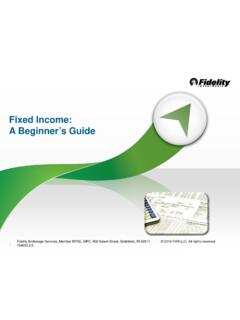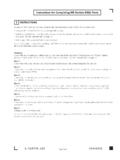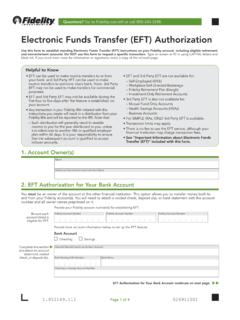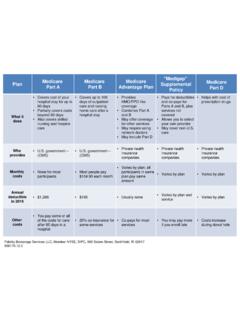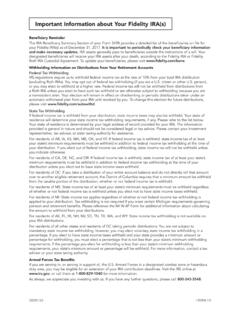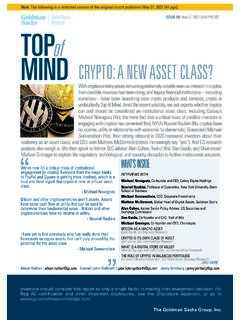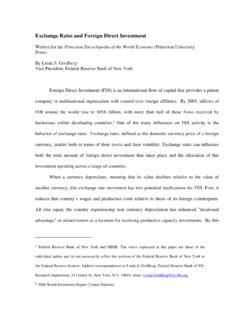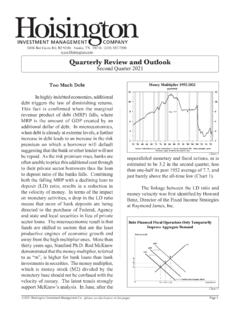Transcription of Investment Strategy
1 PInvestment StrategyInterpreting key concepts and choosing appropriate strategiesContents Asset Allocation 2 Strategic asset allocation 6 Tactical allocation 8 Choosing the appropriate mix 9 Portfolio rebalancing10 Disciplined investing13 Managing your portfolio Ta x Ef fic ie n c y14 Tax-efficient investing15 Asset location 16 Tax-loss harvesting17 Tax-smart Investment management1 Your Next Steps18 Put your strategies to work19 Important informationINVESTMENT STRATEGY1 Designing your specialized Investment strategyYour goals are as unique as you are. That s why your personal Investment Strategy needs to reflect the following: Where you re headed How you plan to get there What your specific objectives are When you want to achieve them What level of risk you re willing to accept to reach your goals In this discussion guide, we ll take a look at how you can use several Investment strategies to serve your family s unique needs.
2 The strategies are broken into two categories asset allocation and tax EfficiencyAsset AllocationAt Fidelity, we believe: Asset allocation is the single most important factor in assessing the long-term risk- and-return characteristics of a diversified portfolio. Efficient portfolio diversification can be one way to lower a port-folio s risk while maintaining its expected Fidelity, we believe: Overlooking the potential impact taxes can have on Investment returns is one of the most common mistakes investors make. The type of account in which you hold certain assets can make a major difference in how much you can earn, after tax, over ReviewAt Fidelity, we believe:Investors should begin the portfolio review process by clearly defining their investing goals and time frame, then commit to periodic reviews of their STRATEGY2 Strategic asset allocationBuild a Strategy designed for your needs, and stay committed to it.
3 Asset allocation is the single most important factor in assessing the long-term risk-and-return characteristics of your portfolio. research shows that the Strategy of selecting the percentage of stocks, bonds, and cash in a portfolio can be said to be responsible for more than 90% of the variability in portfolio asset allocation decisions can cause the returns of the average stock or bond investor to lag the respective markets. You should allocate your investments across stocks, bonds, and cash to help reduce portfolio risk, seek attractive returns, and avoid the pitfalls of market timing. In addition, investors with longer time horizons have the capacity to accept a higher level of portfolio volatility associated with a more significant weighting in equities, which should include broadly diversified international funds to take advantage of diversification benefits outside the United your asset time horizon, current financial situation, and tolerance for market swings will influence how aggressively or conservatively you choose to invest.
4 Investors can trail the market significantly. Decisions by investors to get in and out of the market or to select underperforming investments can cause them to generate far lower returns than the overall market. UNDERSTAND YOUR RISK TOLERANCE LessAggressiveProfileMoreAggressiveProfi leTime HorizonShort-term goalNo emergency fundsDecreasing future incomeLarge amount of debtMarket changes cause anxietyLong-term goalAdequate emergency fundsIncreasing future incomeSmall amount of debtComfort with market changesCurrent Financial SituationRisk ToleranceASSET ALLOCATION Where do you fall on the spectrum of time horizon, current financial situation, and risk tolerance? How has your risk tolerance influenced your Investment decisions?QASSET ALLOCATION3 Consider portfolio diversification and select your target asset diversification is the mix of stocks, bonds, and cash held in a portfolio.
5 One way to help protect yourself from the unpredictability of the market may be to diversify your holdings across these three main types of investments. This approach can help lower the risks associated with having all your money in only one type of Investment . Your asset mix depends largely on your specific financial situation. Typically, a longer investing time frame allows for a higher percentage of stocks in your portfolio. If you are near retirement you may want to consider a gradual process of transitioning into a lower volatility asset mix. Keep in mind that retirement for some investors could last 30 years or longer, so the growth potential of your portfolio should still be an important consideration when selecting your Investment :n Short-Termn Foreign Stocksn Domestic Stocks n BondsASSET ALLOCATION What has led you to arrive at your current asset mix?
6 QTARGET ASSET MIXESS hort-TermConservativeModerate with IncomeModerateBalancedGrowth with IncomeGrowthAggressive GrowthMost AggressiveMay be appropriate for investors who: Seek to preserve capital Seek to minimize fluctuations in market values Seek income and the potential for capital appreciation, with a slight priority on income Seek income and the potential for capital appreciation, with a slight priority on capital appreciation Seek potential for capital appreciation and some growth Seek moderate growth and income Have a preference for growth Seek aggressive growth Seek very aggressive growth Can accept the lowest returns in exchange for price stability Take an income-oriented approach with some potential for capital appreciation Can withstand moderate fluctuations in market values Can withstand moderate fluctuations in market values Can withstand moderate fluctuations in market value Can withstand moderate fluctuations in market values Can withstand significant fluctuations in market value Can tolerate wide fluctuations in market values, especially over the short term Can tolerate very wide fluctuations in market values.
7 Especially over the short term100%Short Term30%Short Term14% Stocks50%Bonds6%Int l Stocks10%Short TermShort TermAggressiveGrowthMostAggressiveConser vativeBalancedGrowth35% Stocks40%Bonds15%Int l Stocks5%Short Term49% Stocks25%Bonds21%Int l Stocks60% Stocks15%Bonds25%Int l Stocks70% Stocks30%Int l Stocks100%30%20%15%21%28%14%50%50%45%6%9 %12%10%35%40%15%5%49%25%21%60%15%70%30%2 5%5%42%35%18% Investment STRATEGY4 Consider your asset mix return and volatility , as a portfolio s stock exposure increases, the potential for both higher returns and larger losses also increases. However, over longer time periods, volatility of returns is reduced. Source: Fidelity Investments and Morningstar Inc. Hypothetical value of assets held in untaxed portfolios invested in US stocks, foreign stocks, bonds, or short-term investments. US stocks, foreign stocks, bonds, and short-term investments are represented by total returns of the IA SBBI US Large Stock TR USD Ext 1/1926 1/1987, Dow Jones Total Market 2/1987 12/2019; IA SBBI US Large Stock TR USD Ext 1/1926 12/1969, MSCI EAFE 1/1970 11/2000, MSCI ACWI Ex USA GR USD 12/2000 12/2019; US Intermediate-Term Government Bond Index 1/1926 12/1975, Bloomberg Barclays US Aggregate Bond 1/1976 12/2019; and 30-Day US Treasury Bills.
8 Standard deviation does not indicate how the securities actually performed but indicates the volatility of their returns over time. A higher standard deviation indicates a wider dispersion of past returns and thus greater historical volatility. The chart does not represent the performance of any Fidelity fund. You cannot invest directly in an index. Stock prices are more volatile than those of other securities. Government bonds and corporate bonds have more moderate short-term price fluctuation than stocks but provide lower potential long-term returns. US Treasury bills maintain a stable value if held to maturity, but returns are generally only slightly above the inflation rate. The purpose of the asset mixes is to show how asset mixes may be created with different risk-and-return characteristics to help meet an investor s goals. You should choose your own investments based on your particular objectives and situation.
9 Remember that you may change how your account is invested. Be sure to review your decisions periodically to make sure they are still consistent with your goals. Past performance is no guarantee of future results. Asset allocation does not ensure a profit or guarantee against a asset allocation (continued)ASSET ALLOCATIONASSET MIX RISK AND RETURNA nnual Return Percentage (%)Risk % (Standard Deviation of Return)03691248121620100%30%14%50%6%20%2 1%50%9%15%28%45%12%10%35%40%15%5%42%35%1 8%5%49%25%21%60%15%25%70%30%Legend:n Short-Termn Foreign Stocksn Domestic Stocksn BondsShort-TermConservativeModerate with IncomeModerateBalancedGrowth with IncomeGrowthAggressive GrowthMost AggressiveAverage 3 3 %7. 9 3 % % ALLOCATION5In the six-year period from 2008 to 2014, the diversified portfolio provided a significant percentage of the all-stock portfolio s returns but with smaller price swings.
10 The diversified portfolio had significantly larger returns than the all-cash : Strategic Advisers LLC. Hypothetical value of assets held in untaxed accounts of $100,000 in an all cash portfolio; a diversified growth portfolio of 49% stocks, 21% international stocks, 25% bonds, and 5% short-term investments; and all stock-portfolio of 70% stocks and 30% international stocks. This chart s hypothetical illustration uses historical monthly performance from January 2008 through February 2014 from Morningstar/Ibbotson Associates; stocks are represented by the S&P 500 and MSCI EAFE Indexes; bonds are represented by the Bloomberg Barclays US Intermediate Government Treasury Bond Index; and short-term investments are represented by 30-day T-bills. Chart is for illustrative purposes only and is not indicative of any Investment . Past performance is no guarantee of future results.

